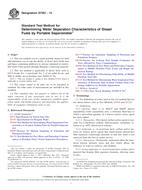We need your consent to use the individual data so that you can see information about your interests, among other things. Click "OK" to give your consent.
ASTM D5598-01(2012)
Standard Test Method for Evaluating Unleaded Automotive Spark-Ignition Engine Fuel for Electronic Port Fuel Injector Fouling
STANDARD published on 1.11.2012
The information about the standard:
Designation standards: ASTM D5598-01(2012)
Note: WITHDRAWN
Publication date standards: 1.11.2012
SKU: NS-31817
The number of pages: 12
Approximate weight : 36 g (0.08 lbs)
Country: American technical standard
Category: Technical standards ASTM
The category - similar standards:
Annotation of standard text ASTM D5598-01(2012) :
Keywords:
deposit control additive, deposits (in internal combustion engines), driveability, electronic port fuel injector (PFI), flow rate, fouling, fuel rail, hot soak, pintle, spark-ignition engine fuel, ICS Number Code 75.160.20 (Liquid fuels)
Additional information
| Significance and Use | ||||||||
|
5.1 Test Method—Deposits are prone to form on the metering surfaces of pintle-type electronic fuel injectors. These deposits reduce fuel flow through the metering orifices. Reductions in metered fuel flow result in an upset in the air-fuel ratio, which can affect emissions and driveability. When heavy enough, these deposits can lead to driveability symptoms such as hesitation, hard starting, loss of power, or a combination thereof, that are easily noticed by the average driver and lead to customer complaints. The mechanism of the formation of deposits is not completely understood. It is believed to be influenced by many factors, including driving cycle, engine design, port fuel injector design, and composition of fuel used. The procedure in this test method has been found to build deposits in injectors on a consistent basis. The deposits formed by this procedure are similar to the deposits experienced in the field in terms of composition and in amount of deposition. This procedure can be used to evaluate differences in unleaded base fuels and fuel additives. 5.1.1 State and Federal Legislative and Regulatory Action—Legislative and regulatory activity, primarily by the state of California6 and the Federal Government5.1.2 Relevance of Results—The operating conditions and design of the engine and vehicle used in this test method are not representative of all modern automobiles. These factors must be considered when interpreting test results. 5.2 Test Validity: 5.2.1 Procedural Compliance—The test results are not considered valid unless the test is completed in compliance with all requirements of this test method. Deviations from the parameter limits presented in Section 5.2.2 Vehicle Compliance—A test is not considered valid unless the vehicle has met the quality control inspection requirements in accordance with 8.2. |
||||||||
| 1. Scope | ||||||||
|
1.1 This test method covers a vehicle test procedure to evaluate the tendency of an unleaded spark-ignition engine fuel to foul electronic port fuel injectors (PFI). 1.2 The test method is applicable to unleaded spark-ignition engine fuels which may contain antioxidants, corrosion inhibitors, metal deactivators, dyes, deposit control additives, and oxygenates. 1.3 The values stated in SI units are to be regarded as the standard. The values in parentheses are provided for information only. 1.4 This standard does not
purport to address all of the safety concerns, if any, associated
with its use. It is the responsibility of the user of this standard
to establish appropriate safety and health practices and determine
the applicability of regulatory limitations prior to use.
Standard Specification for Mineral
Spirits (Petroleum Spirits) (Hydrocarbon Dry Cleaning Solvent) Standard Specification for Automotive
Spark-Ignition Engine Fuel (Includes all amendments and changes
12/14/2023). MC 96.1 Temperature Measurement Thermocouples Title 1—Provisions for Attainment and Maintenance of
National Air Quality Standards, Clean Air Act Amendments of 1990
Public Law 101-549, Nov. 15, 1990. Clean Air Act Amendments of
1990, Available from Superintendent of Documents, U.S. Government
Printing Office, Washington, DC 20402. |
Similar standards:
Historical
15.7.2011
Historical
15.6.2013
Historical
1.10.2013
Historical
1.5.2013
Historical
15.6.2013
Historical
1.5.2013
We recommend:
Technical standards updating
Do you want to make sure you use only the valid technical standards?
We can offer you a solution which will provide you a monthly overview concerning the updating of standards which you use.
Would you like to know more? Look at this page.



 ASTM D7223-11
ASTM D7223-11 ASTM D7224-13
ASTM D7224-13 ASTM D7236-07(2013)..
ASTM D7236-07(2013).. ASTM D7261-13
ASTM D7261-13 ASTM D7318-13
ASTM D7318-13 ASTM D7319-13
ASTM D7319-13
 Cookies
Cookies
